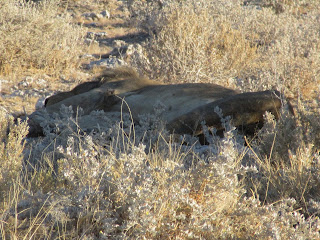Saturday morning we started our drive to the
guesthouse on the southern side of the park. The main road has a lot of side
roads to waterholes, and we took most of them, having a leisurely drive to see
as many animals as possible.
The terrain changed as we drove through the park.
Since we were driving near the salt pan, the
ground and trees were covered with white dust.
The acacia trees were leafless
and short.
In other places there was grass.
On the hills at Halil there are ghost trees,
named because the trunks are white and they have no leaves. However, beside the
waterhole there is a ghost tree with leaves because of the supply of water.
The natural waterholes are scenic in themselves
even without animals.
But animals add a special element to the beauty.
Repeating animal highlights
One waterhole had a bunch of kudu along with some
impalas.
In another section there were zebra and an ostrich and guinea fowl
were walking around.
A watch zebra stood in the road while others approached
and crossed the road.
An old elephant approached the road and crossed
in front of us.
Elephants interacting
We saw several special birds:
Hornbill
Kori bustard
Secretary bird
Lilac breasted roller
New animals of the day:
Red hartebeest
At the end of a loop road there was a bunch of
banded mongooses heading for the shade under a tree. When they got there, they
piled up or stretched out in the shade. Morne stopped the car, and when he
started it again they all got up and ran to the other side of the tree.
Morne spotted a honey badger curled up on the
side of the road. First we thought it was dead because it was so still and was
right next to the road. Then it started throwing dust onto itself, making Morne
think something was wrong with it. After a few minutes it stood up and walked
inland.
At about 4:15 we had to decide if we would take
the alternate road to a few waterholes or take the main road directly to the
rest camp. Morne decided on the latter because we needed to arrive before 5:30
and the alternate road would have taken too long. After twenty minutes we saw a
couple cars parked near a tree that is known to often have a lion under it.
Sure enough, he was there lying on the ground. From the road, he looked like a
rock,
and the telephoto or binoculars were needed to determine that it was a
lion.
When we went to the other side of the tree as we left, we had a clearer
view. Even though he was sleeping and not very visible, it was still exciting
to see a lion. We were glad Morne had chose that route.
On the way to the rest camp, we came across two
black backed jackals
and a bat eared fox. The fox took off running after a
springbok that Morne said he had no hope of catching, but it was fun to watch.
Then a spotted hyena came walking along.
We arrived at Okaukuejo with time to spare, as it
was only 5:15. This guesthouse is known for its well-lit waterhole to which
many animals come.
Before dinner I saw two small white rhinos, which was
exciting because it was the first time I’d seen rhinos close enough to know
that they were rhinos. (I’d seen one way way in the distance in Kenya, and it
was a black rhino.)
At 10:30 I returned and immediately saw two big
rhinos, one on each side of the waterhole. I was really excited to see them so
close and so well. I went back to the room to tell Kate so she could come out
if she wanted to; she did. The one on the far side had left when I returned, but
then two more came.
The rhino at the waterhole went to greet them. Morne
explained in the morning that it was checking them out to see if it was OK to
share the space, as they are territorial; it was. So then there were three
rhinos. I stayed until 11:30.
Since I’d seen the rhinos, which was what I was
hoping to see at the waterhole because both Rachel and Chris had talked about
seeing many rhinos there, I didn’t get up in the middle of the night to go to
the waterhole. When I went at 5:30 AM, nothing was happening. A springbok came,
and there were giraffes way in the distance. But otherwise it was quiet.


































No comments:
Post a Comment